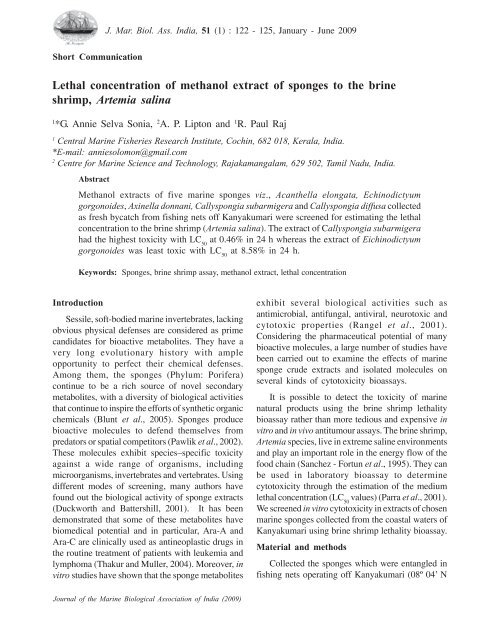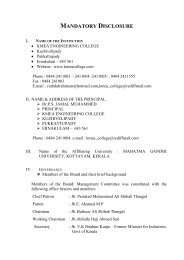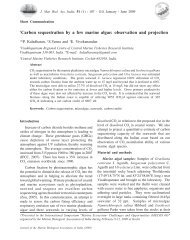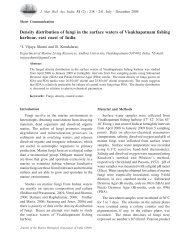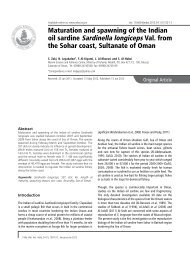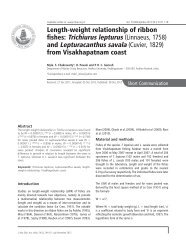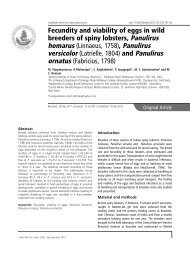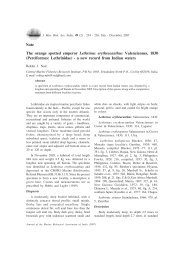Annie Selva Sonia - MBAI - The Marine Biological Association of India
Annie Selva Sonia - MBAI - The Marine Biological Association of India
Annie Selva Sonia - MBAI - The Marine Biological Association of India
Create successful ePaper yourself
Turn your PDF publications into a flip-book with our unique Google optimized e-Paper software.
124G. <strong>Annie</strong> <strong>Selva</strong> <strong>Sonia</strong> et al.Table 2. LC 50(% extract) value <strong>of</strong> sponge metabolites to ArtemiasalinaSpongesLC 50( in % extract)Acanthella elongata 0.51Echinodictyum gorgonoides 8.58Axinella donnani 5.30Callyspongia subarmigera 0.46Callyspongia diffusa 5.40Discussion<strong>The</strong> brine shrimp larval mortality assay is widelyaccepted as a convenient probe for potential in vitrocytotoxicity and pharmacological activity in marinenatural products (Carballo et al., 2002). <strong>The</strong> assayshowed a good correlation with cytotoxicity in celllines such as 9KB, P388, L5178Y and L1210 (DeRosa et al., 1994; McLaughlin et al., 1998). <strong>The</strong>brine shrimp assay has a number <strong>of</strong> advantages suchas experimental simplicity, sensitivity, reproducibility,rapid (24 hours), inexpensive, simple and reliableway <strong>of</strong> determining the intensity <strong>of</strong> cytotoxicity(Lieberman, 1999).Sponges <strong>of</strong> the class Demospongiae are known toproduce the largest number and diversity <strong>of</strong> secondarymetabolites isolated from marine invertebrates, most<strong>of</strong> them with medically relevant biological activitiesand important ecological roles (Faulkner, 2002). <strong>The</strong>toxicity <strong>of</strong> sponges has been well-documented, whichcould be ascribed to the diverse and potent cytotoxiccompounds (Lee and Qian, 2003). Studies made byZhang et al. (2003) revealed that more than 10% <strong>of</strong>the investigated marine sponge species exhibitedcytotoxic activity suggesting production <strong>of</strong> potentialmedicines. In the present study, the results <strong>of</strong> brineshrimp lethality indicated that the extract <strong>of</strong> C.subarmigera was highly active with LC 50value <strong>of</strong>0.46% followed by other extracts. E. gorgonoideswas found to contain the least toxicity (LC 50= 8.58%).Selvin and Lipton (2004) studied brine shrimp toxicity<strong>of</strong> sponges like Clathria gorgonoides, Dendrilla nigraand Axinella donnani and reported that the LC 50was0.20%, 0.28% and 5.5%, respectively. Variations intoxicity could be attributed due to the changes in theecology and metabolism <strong>of</strong> the respective species(Becerro et al., 2003).Cytotoxicity <strong>of</strong> marine sponges against brineshrimp has been studied by a few authors. <strong>The</strong>bioactive acetylenic compound isolated from theCaribbean sponge Cribrochalina vasculum wasfound to be highly toxic to Artemia salina (Aielloet al., 1992). <strong>The</strong> crude extracts <strong>of</strong> the marinesponges Pachastrella sp. and Jaspis sp. collectedfrom the South Sea <strong>of</strong> Korea exhibited significantbrine shrimp cytotoxicity; further purification gavePectenotoxin and Psammaplin A, which werecytotoxic to human cancer cell lines (Jung et al.,1995). Qureshi et al. (1998) found that peroxidesfound in the Philippine marine sponge, Plakinastrellasp. was toxic to Artemia salina. Earlier studiesconducted using the methanol extract <strong>of</strong> the Koreansponge, Petrosia sp. showed potent brine shrimpcytotoxicity. Guided by this assay, furtherfractionation and purification gave potent cytotoxicpolyacetylenes (Kim et al., 1999). <strong>The</strong> Indonesiansponge, Callyspongia pseudoreticulata yielded diynewhich was found to be toxic in the brine shrimpassay (Braekmam et al., 2003). <strong>The</strong> present studyindicates that the extract <strong>of</strong> Callyspongiasubarmigera could be further fractionated to yieldpotent cytotoxic drugs.Acknowledgements<strong>The</strong> authors are thankful to the Director, CMFRI,Kochi for the facilities provided. <strong>The</strong>y are alsograteful to the ICAR for providing fellowship to thefirst author.ReferencesAiello, A., E. Fattorusso, M. Menna and M. Pansini. 1992.Further bioactive acetylenic compounds from the Caribbeansponge, Cribrochalina vasculum. J. Nat. Prod., 55: 1775 -1780.Becerro, M. A., R. W. Thacker, X. Turon, M. J. Uriz and V. J.Paul. 2003. Biogeography <strong>of</strong> sponge chemical ecology:comparisons <strong>of</strong> tropical and temperate defences. Oceologia,135: 91 - 101.Blunt, J. W., B. R. Copp, M. H. Munro, P. T. Northcote and M.R. Prinsep. 2005. <strong>Marine</strong> natural products. Nat. Prod. Rep.,22: 15 - 61Braekman, J. C., D. Daloze, D. Devijver and van R. W. M. Soest.2003. New cytotoxic compound from the Indonesian sponge,Callyspongia pseudoreticulata. J. Nat. Prod., 66: 871 - 872.Carballo, J. L., Z. L. Hernandez-Inda, P. Perez and M. D.Garciía-Gravalos. 2002. A comparison between two brineshrimp assays to detect in vitro cytotoxicity in marine naturalproducts. BMC Biotechnology, 2: 17 - 18.Journal <strong>of</strong> the <strong>Marine</strong> <strong>Biological</strong> <strong>Association</strong> <strong>of</strong> <strong>India</strong> (2009)
Lethal concentration <strong>of</strong> methanol extract125De Rosa, S., A. De Giulio and C. Iodice. 1994. <strong>Biological</strong> effects<strong>of</strong> prenylated hydroquinones: structure-activity relationshipstudies in antimicrobial, brine shrimp and fish lethality assays.J. Nat. Prod., 57: 1711 - 1716.Duckworth, A.R. and C. N. Battershill. 2001. Population dynamicsand chemical ecology <strong>of</strong> New Zealand DemospongiaeLatrunculia sp. nov. and Polymastia croceus (Poecilosclerida:Latrunculiidae: Polymastiidae). New Zeal. J. Mar. Fresh.Res., 35: 935 - 949.Faulkner, D. J. 2002. <strong>Marine</strong> natural products. Nat. Prod. Rep.,19:1 - 48.Jung, J. H., J. Shin, Y. Seo and C. J. Sim. 1995. Bioactivecompounds from the marine sponges Pachastrella sp. andJaspis sp. J. Toxicol. Toxin. Rev., 14: p. 138.Kim, J. S., Y. Y. Lim, I. Siklm, J. H. Jung, C. H. Stim, C.O.Lee, J. Hong and H. Lee. 1999. Cytotoxic polyacetylenesfrom the marine sponge Petrosia sp. J. Nat. Prod.,62: 554 - 559.Lee, O. and P. Y. Qian. 2003. Chemical control <strong>of</strong> bacterialepibiosis and larval settlement <strong>of</strong> Hydroides elegans in thered sponge Mycale adherens. Bi<strong>of</strong>ouling, 19: 171 - 180.Lewis, G. E. 1995. Testing the toxicity <strong>of</strong> extracts <strong>of</strong> SouthernAfrican plants using brine shrimp (Artemia salina). S. Afr.J. Sci., 91: p. 382.Lieberman, M. 1999. A brine shrimp bioassay for measuringtoxicity and remediation <strong>of</strong> chemicals. J. Chem. Educ., 76:1689 - 1690.McLaughlin, J. L., L. L. Rogers and J. E. Anderson. 1998. <strong>The</strong>use <strong>of</strong> biological assays to evaluate botanicals. Drug. Inf. J.,32, 513 - 524.Meyer, B. N., N. R. Ferrigni, J. E. Putnam, L. B. Jacobsen, D.E. Nichols and J. L. McLaughlin. 1982. Brine shrimp: aconvenient general bioassay for active plant constituents.Planta Medica., 45: 31 - 34.Miller, L. C. and M. L. Tainter. 1994. Estimation <strong>of</strong> the ED 50andits error by means <strong>of</strong> lagrathimic – probit graph paper. Proc.Soc. Exp. Bio. Med., 57: 261 - 264.Parra, A. L., R. S. Yhebra, I. G. Sardinas and L. I. Buela. 2001.Comparative study <strong>of</strong> the assay <strong>of</strong> Artemia salina L. and theestimate <strong>of</strong> the medium lethal dose (LD 50value) in mice, todetermine oral acute toxicity <strong>of</strong> plant extracts. Phytomedicine,8: 395 - 400.Pawlik, J. R., G. McFall and S. Zea. 2002. Does the odor fromsponges <strong>of</strong> the genus Ircinia protect them from fish predators?J. Chem. Ecol., 28: 1103-1115.Quershi, A., J. Salva, M. K. Harper, and D. J. Faulkner. 1998.New cyclic peroxides from the Philippine spongePlakinastrella sp. J. Nat. Prod., 61: 1539 - 1542.Rangel, M., B. De Sanctis, J. C. Freitas, J. M. Polatto, A. C.Granato, R. G. S. Berlinck and E. Hajdu. 2001. Cytotoxicand neurotoxic activities in extracts <strong>of</strong> marine sponges(Porifera) from southeastern Brazilian coast. J. Exp. Mar.Biol. Ecol., 262: 31 - 40.Sanchez-Fortun, S., F. Sanz-Barrera and M. V. Barahona-Gomariz.1995. Acute toxicities <strong>of</strong> selected insecticides to the acuaticarthropod Artemia salina. Bull. Environ. Contam. Toxicol.,54: 76 - 77.Selvin, J. and A. P. Lipton. 2004. Biopotentials <strong>of</strong> secondarymetabolites isolated from marine sponges. Hydrobiologia,513: 231 - 238.Thakur, N. L. and W. E. G. Muller. 2004. Biotechnological potential<strong>of</strong> marine sponges. Curr. Sci., 86: 1506 - 1512.Zhang, W., X. Zhang, X. Cao, J. Xu , Q. Zhao and X. Yu. 2003.Optimizing the formation <strong>of</strong> in vitro sponge primmorphsfrom the Chinese sponge Stylotella agminata (Ridley). J.Biotechnol., 100: 161 - 168.Received : 25/04/08Accepted : 18/05/09Journal <strong>of</strong> the <strong>Marine</strong> <strong>Biological</strong> <strong>Association</strong> <strong>of</strong> <strong>India</strong> (2009)


